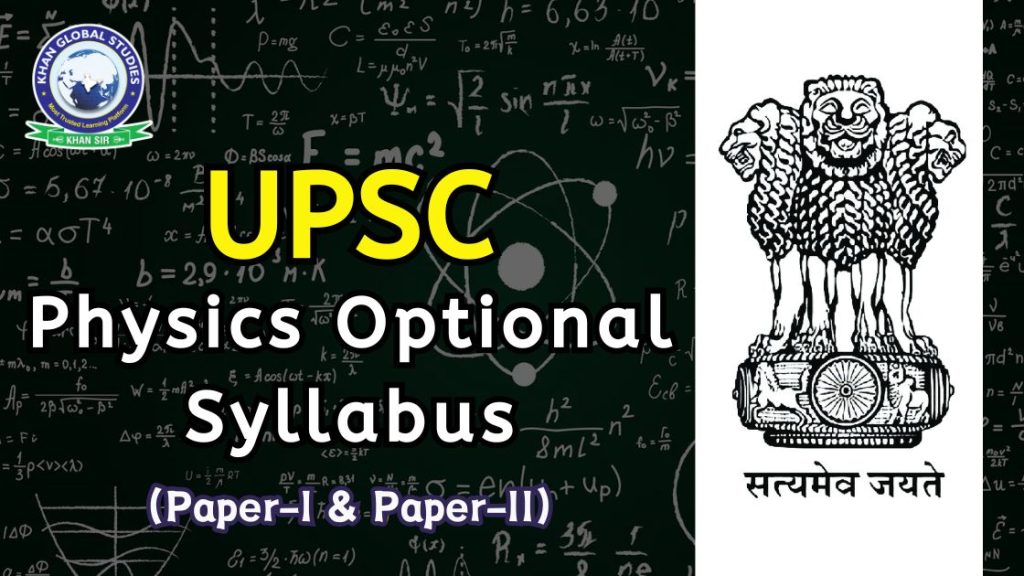UPSC Physics Optional Syllabus is designed for candidates with a Physics background at undergraduate or postgraduate level. It covers subjects at the undergraduate degree level and is divided into two papers, each worth 250 marks. While preparing for UPSC Physics Optional, candidates should adopt a strategic approach because of the special nature of the subject.
UPSC Physics Optional Syllabus
Physics is a fundamental subject in the field of science that demands deep understanding and wide practice. UPSC Physics Optional Syllabus consists of two papers, Paper 1 and Paper 2 in UPSC Mains Exam. Each paper carries 250 marks making a total of 500 marks for the subject.
| UPSC Physic Optional Syllabus | Topics |
| Paper 1 | Mechanics of Particles Waves and Optics Electricity and Magnetism Electromagnetic Waves and Blackbody Radiation Thermal and Statistical Physics |
| Paper 2 | Quantum Mechanics Atomic and Molecular Physics Nuclear and Particle Physics Solid State Physics, Instruments and Electronics |
UPSC Physics Optional Syllabus Paper 1
Classical Mechanics
- Particle Dynamics: centre of mass and labial coordinates, conservation of linear and angular momentum
- Rocket equation, Rutherford scattering, Galilean transform, inertial and non-inertial frames
- Rotating frame, centrifugal and Coriolis forces, Foucault pendulum
- Systems of particles: constraints, degrees of freedom, generalized coordinates and momentum
- Lagrange’s equation and applications to linear harmonic oscillator, simple pendulum and central force problems.
- Hamiltonian Lagrange equation from cyclic coordinates, Hamilton’s principle
- Dynamics of rigid bodies: Eulerian angles, inertia tensor, principal moments of inertia. Euler’s equation of motion of a rigid body, force-free motion of a rigid body. Gyroscope
- Special relativity: the Michelson–Morley experiment and its implications
- Lorentz transformation- length contraction, time dilation, sum of velocities, diffraction and Doppler effect, mass-energy relation, simple applications to decay process.
- Minkowski diagram, four-dimensional momentum vector. covariance of physics equations
- Waves: Simple Harmonic Motion, Damped Oscillation, Forced Oscillation and Resonance
- Beats. Standing waves in a wire. pulses and wave packets
- Phase and group velocities. Reflection and refraction from Huygens’ principle
- Geometric Optics: Laws of Reflection and Refraction from Fermat’s Principle
- Matrix method, nodal plane, a system of two thin lenses, a chromatic and spherical aberration in paraxial optic-thin lens formula.
Waves and Optics
- Interference: Interference of light – Young’s experiment, Newton’s rings, interference by thin films, Michelson interferometer.
- Multiple beam interference and the Fabry–Pérot interferometer. Holography and simple applications
- Diffraction: Fraunhofer Diffraction-Single Slit, Double Slit, Diffraction Grating, Resolving Power. Fresnel Diffraction:- Quasi-periodic spheres and spherical plates
- Fresnel integrals. Application of Cornu’s spiral to the analysis of diffraction along a straight edge and by a long narrow slit. Diffraction by circular aperture and airy pattern
- Polarization and modern optics: generation and detection of linearly and circularly polarized light. double refraction, a quarter-wave plate
- Optical Activity. Principles of fiber optics attenuation; Phase-index and parabolic index pulse dispersion in fibers; Material dispersion, single-mode fiber. laser
- Einstein A and B coefficients, Ruby and He-Ne Ledger. Characteristics of laser light-spatial and temporal coherence. Focusing laser rays. Three-tier plan for laser operation.
Electricity and Magnetism
- Electrostatics and Magnetostatics: Laplace ad Poisson equation in electrostatics and their applications.
- The energy of a system of charges, multipolar expansion of the scalar potential. Image methods and their applications
- Potential and field due to a dipole in an external field, force and torque on a dipole. Dielectric, polarisation. Solution of boundary-value problems-conducting and dielectric fields in a uniform electric field
- Magnetic coil, uniform magnetic field. Ferromagnetic materials, hysteresis, energy loss
- Current Electricity: Kirchhoff’s laws and their applications. Biot-Savart Law, Ampere’s Law, Faraday’s Law, and Lenz’s Law.
- Self- and interpersonal-motivation. Mean and RMS values in AC circuits. LR CR and LCR circuits – series and parallel resonance. quality factor. Principle of Transformer.
Electromagnetic Waves and Black Body Radiation
- Electromagnetic Theory: displacement current and Maxwell’s equations. Wave equation in vacuum, Poynting’s theorem
- Vector and Scalar potentials. Gauge invariance, Lorentz and Coulomb gauges. Covariance of the electromagnetic field tensor, Maxwell’s equations
- Wave equation in isotropic dielectrics, reflection and refraction at the interface between two dielectrics. Fresnel’s Relation
- Normal and Abnormal dispersion. Rayleigh scattering. Blackbody Radiation: Blackbody Radiation and Planck Radiation Law – Stefan–Boltzmann Law
- Wien displacement law and Rayleigh-Jeans law. Planck Mass, Planck Length, Planck Time, Planck Temperature and Planck Energy.
Thermal and Statistical Physics
- Thermodynamics: Laws of Thermodynamics, Reversible and Irreversible Processes, Entropy. Isothermal, Adiabatic, Isobaric, Isochoric Processes and Entropy Change
- Otto and diesel engines, Gibbs phase law and chemical potential. Vander Waals equation of state of real gas, critical constant.
- Maxwell-Boltzmann distribution of molecular velocities, transport phenomena, isomerism and virial theorem. Dulong-Petit’s, Einstein’s and Debye’s theories of specific heat of solids. Maxwell relations and applications.
- Clausius–Clapeyron equation. Adiabatic demagnetization, Joule–Kelvin effect and liquefaction of gases Statistical Physics: Saha ionization formula. Bose-Einstein condensation
- Thermodynamic behaviour of an ideal Fermi gas, Chandrasekhar limit, initial ideas about neutron stars and pulsars
- Brownian motion is a random walk, propagation process. Concept of negative temperature.
UPSC Physics Optional Syllabus Paper 2
Quantum Mechanics 1
- Wave-particle duality. The Schroedinger equation and expectation value. uncertainty principle.
- Solutions of one-dimensional Schrödinger equation-free particles (Gaussian wave-packets), particles in a box, particles in a finite well, linear harmonic oscillator
- Reflection and transmission by a step potential and a rectangular barrier. Use of the WKB formula for lifetime calculations in the alpha-decay problem.
Quantum Mechanics 2
- Quantum Mechanics II: Particles in a three-dimensional box, density of states, free electron theory of metals
- Angular momentum problem. Hydrogen Atom. The spin half problem and properties of Pauli spin matrices
- Atomic Physics: Stern-Gerlach experiment, electron spin, fine structure of hydrogen atoms. L-S Coupling, J-J Coupling
- Spectroscopic marking of atomic states. Zeeman effect. Franck–Condon theory and applications.
Molecular Physics
- Elementary theory of rotational, vibrational and electronic spectra of diatomic molecules. Raman effect and molecular structure
- Importance of Neutral Hydrogen Atom, Molecular Hydrogen and Molecular Hydrogen Ion in Laser Raman Spectroscopy Astronomy Fluorescence and Phosphorescence
- Elementary theory and applications of NMR. Elementary ideas about the Transfiguration of the Lamb and its significance.
Nuclear Physics
- Basic atomic properties – size, binding energy, angular momentum, parity and magnetic moment. Semi-empirical mass formulas and applications
- Large scale parabola. The ground state of the deuteron magnetic moment and non-central forces. meson’s theory of nuclear forces
- Main characteristics of nuclear forces. Shell model of the nucleus-success and limitations. Parity violation in beta decay
- Gamma decay and internal conversion. Elementary ideas about Mössbauer spectroscopy. Q-value of nuclear reactions
- Nuclear fission and fusion, energy production in stars. nuclear reactor.
Particle Physics and Solid-State Physics
- Particle Physics: Classification of elementary particles and their interactions. Conservation law. quark structure of hadron
- Field quanta of electroweak and strong interactions. Elementary ideas about integration of forces. physics of neutrinos
- Solid State Physics: Cubic Crystal Structure. Band theory of solids – conductors, insulators and semiconductors. Elements of superconductivity, Meissner effect, Josephson junction and applications.
- Elementary ideas about high-temperature superconductivity.
Electronics
- Intrinsic and extrinsic semiconductor-p-np and np-n transistors. Amplifiers and Oscillators.
- Op-Amps. FET, JFET and MOSFET. Digital Electronics-Boolean Identities, De Morgan’s Laws, Logic Gates and Truth Tables
- Simple logic circuits. Thermistors, solar cells. Fundamentals of Microprocessor and Digital Computer.
Tips to Prepare for UPSC Physics Syllabus
- Understand the syllabus thoroughly: Before you start diving into the study material, it is important to have a clear understanding of the UPSC Physics syllabus. This will help you prioritize your studies and focus on the most important subjects. Familiarize yourself with the importance of each section and the types of questions commonly asked.
- Build a strong foundation: Make sure you have a solid understanding of the fundamental concepts of physics. Revisit your undergraduate or graduate physics syllabus work if necessary. This will make it much easier to understand more advanced topics.
- Choose the right study material: Don’t get overwhelmed by the sheer amount of study material available. Select high-quality textbooks, reference books and online resources that comprehensively cover the UPSC Physics syllabus. Check out recommendations from toppers and experienced teachers.
- Focus on conceptual clarity: Don’t just memorize formulas and equations. Try to understand the theories and concepts underlying them. With this, you can apply your knowledge to different types of problems and get better marks in the examination.
- Practice solving numerical problems: The UPSC Physics exam often involves numerical problems. Practice regularly solving problems from previous years’ question papers, sample papers and reference books. This will improve your problem-solving skills and increase your confidence.
- Develop your writing skills: The UPSC Physics exam is not just about technical knowledge. You also need to be able to communicate your ideas clearly and concisely. Practice writing answers to previous year’s questions in a time-bound manner. This will help you improve your speed and accuracy.
- Take Mock Tests: Mock tests are invaluable tools to assess your preparation and identify your weak areas. Take regular mock tests and analyze your performance to understand your strengths and weaknesses. This will help you focus your studies on the areas where you need the most improvement.
- Join a coaching class (optional): If you feel you need additional guidance and support, consider joining a coaching class. A good coaching class can provide you with structured study material, expert guidance and regular practice tests.
- Stay motivated: Preparing for the UPSC exam can be a long and challenging process. It is important to stay motivated throughout your journey. Set realistic goals, reward yourself for your achievements, and avoid comparing yourself to others.
- Believe in yourself: Have faith in your abilities and don’t give up on your dreams. With hard work, dedication and the right approach, you can achieve your goal of cracking the UPSC Physics exam.
Bonus Tips:
- Use online resources like video lectures, online forums and question banks.
- Create a study group with other UPSC aspirants to discuss concepts and share study material.
- Take good care of your health and well-being. Exercise regularly, eat a healthy diet, and get adequate sleep.
- Stay positive and believe in yourself!
- Remember, cracking the UPSC Physics exam is a challenging feat. But with the right preparation and the right mindset, you can achieve your goal.


